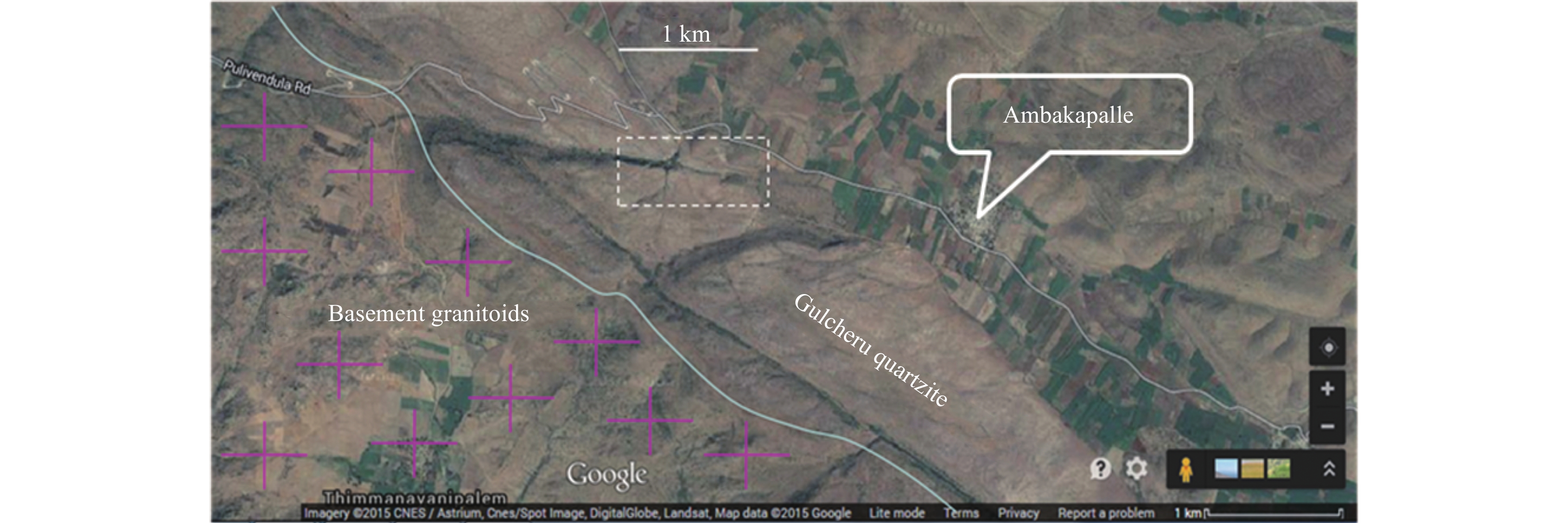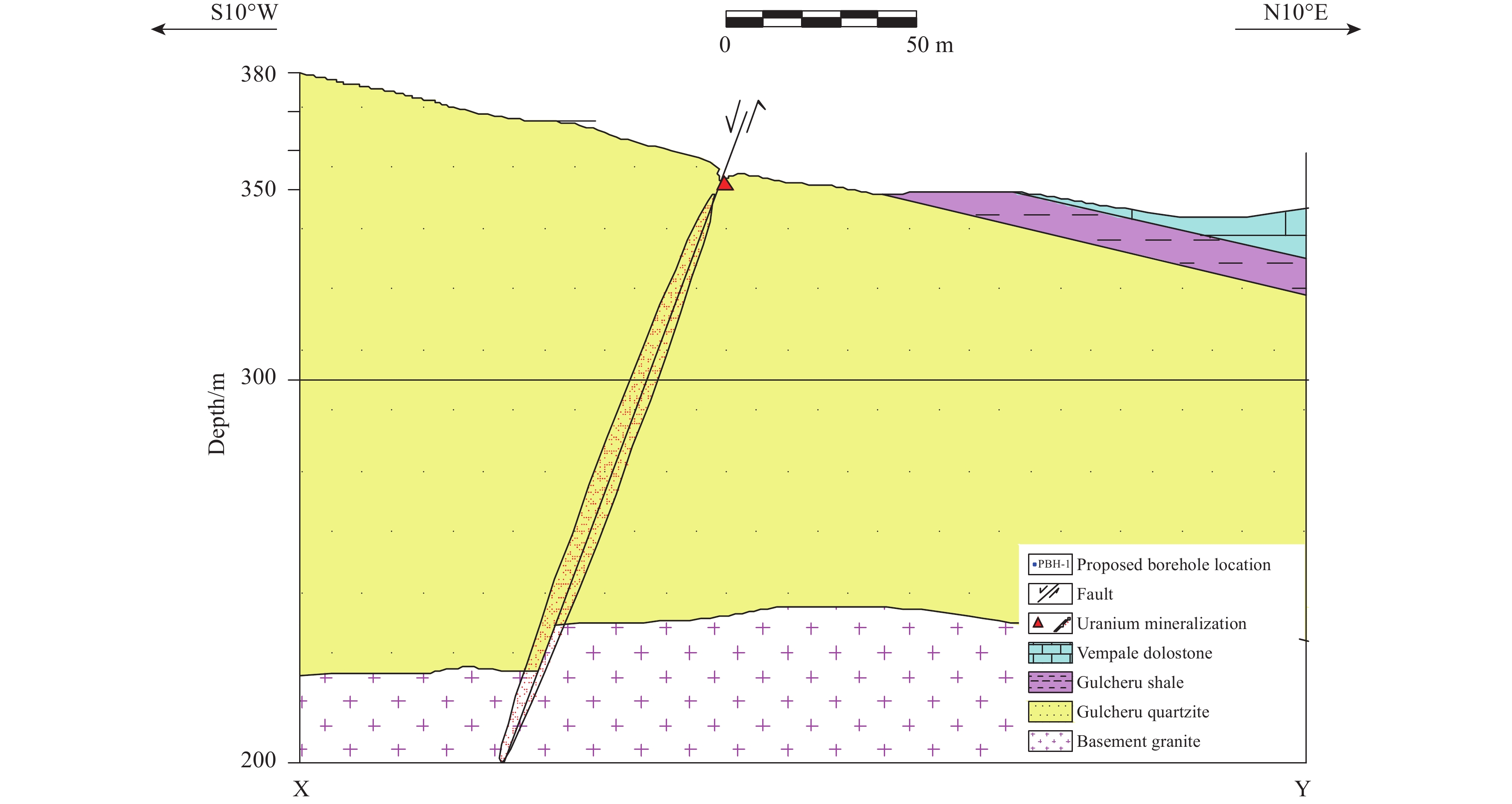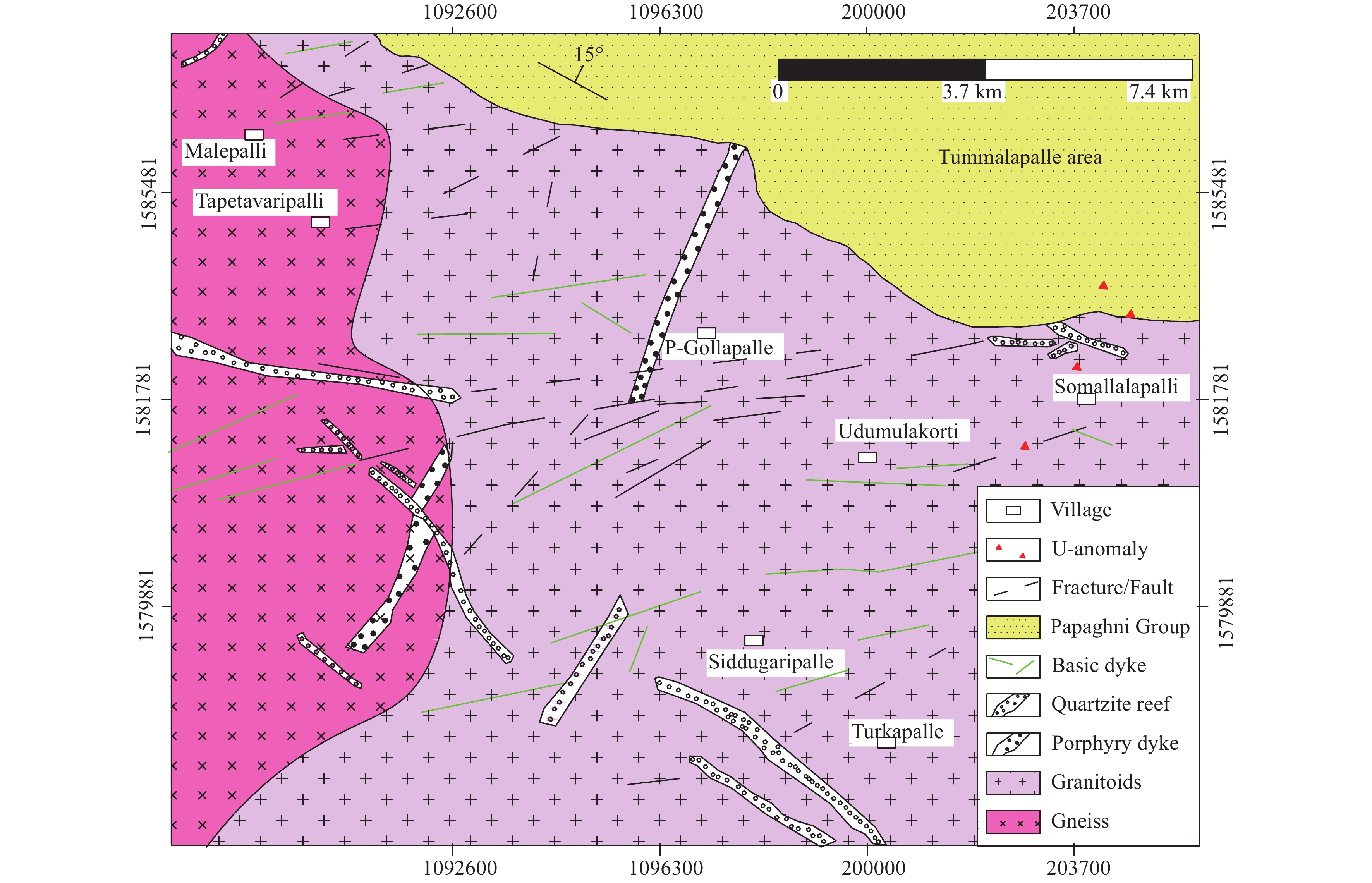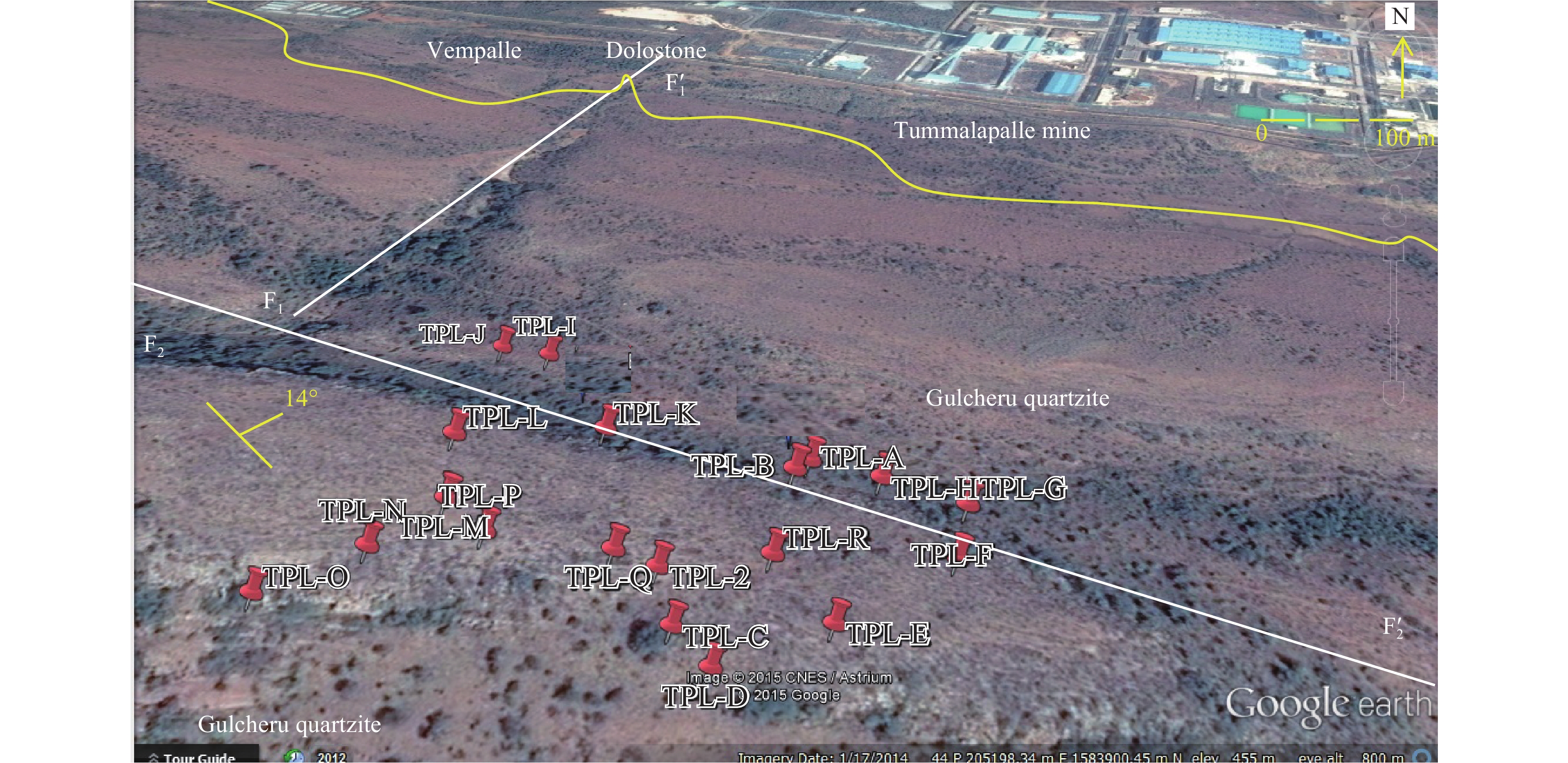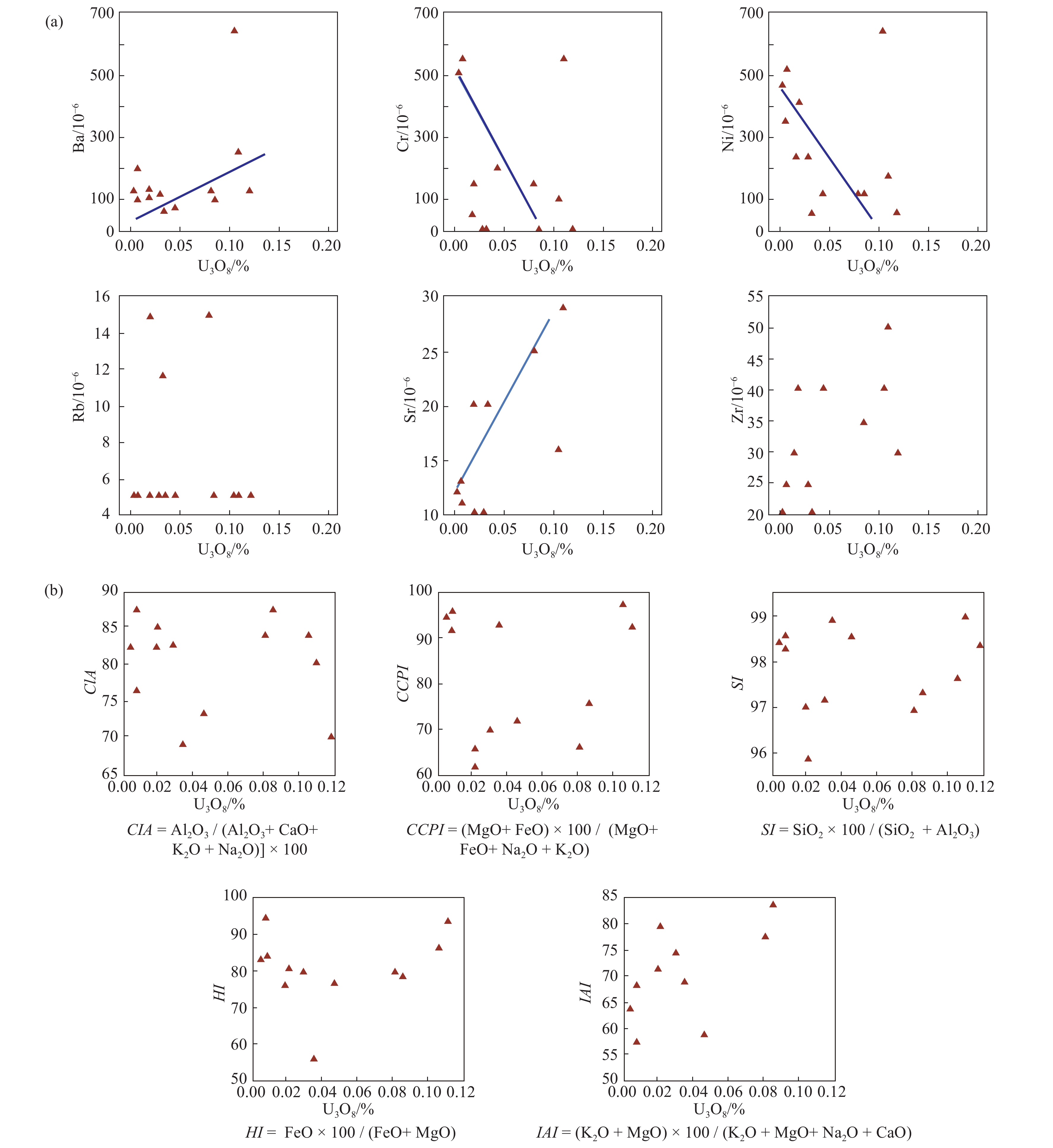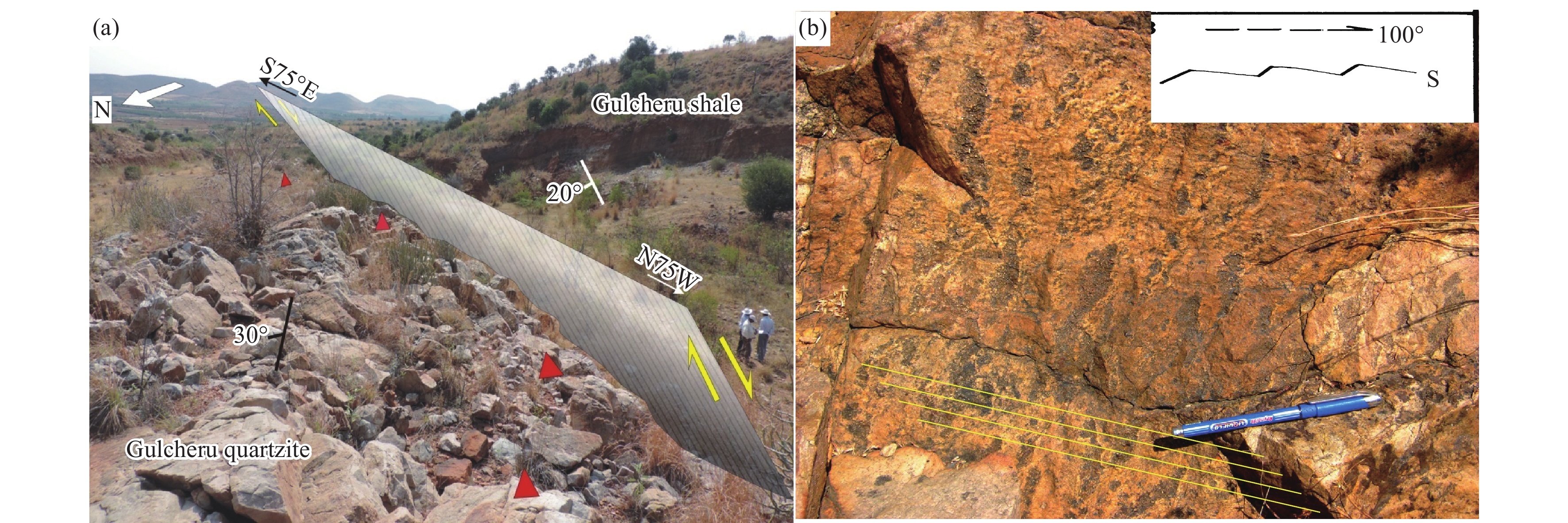| Citation: | Sukanta Goswami, Pradeep Kumar Upadhyay, Bhaskaran Saravanan, V Natarajan, Mohan Babu Verma, 2019. Two types of uranium mineralization in Gulcheru quartzite: Fracture-controlled in Ambakapalle area and litho-controlled in Tummalapalle area, Cuddapah Basin, Andhra Pradesh, India, China Geology, 2, 142-156. doi: 10.31035/cg2018099 |
Two types of uranium mineralization in Gulcheru quartzite: Fracture-controlled in Ambakapalle area and litho-controlled in Tummalapalle area, Cuddapah Basin, Andhra Pradesh, India
-
Abstract
The Cuddapah Basin in southern India has a potential for uranium mineralization due to some favorable factors such as its temporal, stratigraphic and tectonic settings. Systematic exploration program conducted by the Atomic Minerals Directorate for Exploration and Research (AMD) within the Cuddapah Basin resulting in the recognition of distinct types of uranium mineralization, viz., strata bound type, fracture/shear-controlled type and tabular type. The Gulcheru Formation which is the lowermost unit of the Cuddapah Basin is dominantly arenitic in nature. During the exploration works, a number of uranium anomalies were identified with dimensions ranging from 1 m to 1.5 km. Gulcheru quartzite hosted uranium mineralization is intermittent and inconsistent in nature. The anomalous outcrops are distributed over a strike length of ca. 60 km between Gandi in the SE and Ambakapallein the NW. Presently, two different types of uranium mineralization are characterized on the basis of field observations, mapping and structural interpretation, petro-mineralogy and geochemistry. Although the host rock is same for both types, the mechanism of uranium enrichment is totally different. The Ambakapalle uranium mineralization is controlled by fault zone and associated hydrothermal activity. Whereas, the Tummalapalle uranium mineralization is litho-controlled in nature influenced by suitable four ‘P’ factors, i.e., provenance, porosity-permeability, precipitation and preservation. The geochemical characterization of Gulcheru quartzite suggest a passive margin type of provenance setting. Petro-mineralogically the quartz arenite suggests enough textural as well as mineralogical maturity. Ambakapalle quartzite is slightly strained and deformed due to faulting. Analysis of selected samples recorded 0.01% to 0.048% U3O8 and <0.01% ThO2. Petrographic observation revealed that the anomalies were appeared due to secondary uranium minerals occurring as surficial encrustations, fracture filling and lesser irregular patches. Structural analysis suggests the mineralization along E-W trace slip fault is possibly consistent in sub-surface. Tummalapalle quartzite is relatively less deformed arenitic in nature with significant enrichment in MREE. The genetic models for the two types of mineralization is totally different.
-

-
References
[1] Bhatia MR. 1983. Plate tectonics and geochemical composition of sandstones. The Journal of Geology, 9, 611–627. [2] Bhatia MR, Crook, KAW. 1986. Trace element characteristics of graywackes and tectonic discriminations of sedimentary basins. Contributions to Mineralogy & Petrology, 92, 181–193. [3] Dickinson WR, Suczek CA. 1979. Plate tectonics and sandstone composition. AAPG Bulletin, 63(12), 2164–2182. [4] Doblas M. 1998. Slickenside kinematic indicators. Tectonophysics, 295, 187–197. doi: 10.1016/S0040-1951(98)00120-6 [5] Dahlkamp FJ. 1993. Uranium Ore Deposits. Springer-Verlag Berlin Heidelberg, New York. ISBN 3-540-53264-1. [6] Durance EM. 1986. Radioactivity in geology- principles and applications. John Wiley & sons, New York, USA, 1-441. [7] Floyd PA, Winchester JA, Park RG. 1989. Geochemistry and tectonic setting of Lewisian clastic metasediments from the early Proterozoic Loch Maree group of Gairloch, NW Scotland. Precambrian Research, 45, 203–214. doi: 10.1016/0301-9268(89)90040-5 [8] Goswami S. 2014. Role of organic matter in Uranium metallogeny in Vempalle Formation. Homi Bhabha National Institute, India, M. Tech. Thesis Report (unpublished). [9] Goswami S, Mukherjee A, Zakaulla S, Rai AK. 2016. Microbial mat related features in Palaeoproterozoic Gulcheru Formation and their role in low grade Uranium mineralisation. Int J Petrochem Sci Eng, 1(4), 19p. doi: 10.15406/ipcse.2016.01.00019 [10] Goswami S, Bhagat S, Zakaulla S, Suresh Kumar Rai AK. 2017a. Role of organic matter in Uranium mineralisation in Vempalle Dolostone; Cuddapah Basin, India. Journal of Geological Society of India, 89(2), 145–154. doi: 10.1007/s12594-017-0578-y [11] Goswami S, Mukherjee A, Bhattacharjee P, Zakaulla S. 2017b. Primary sedimentary structures and MISS in Gulcheru quartzite along SW part of Cuddapah Basin. Journal of Geological Society of India, 89(5), 511–520. doi: 10.1007/s12594-017-0639-2 [12] Geological Survey of India (GSI). 1981. Explanatory brochure on geological and mineral map of Cuddapah Basin, 121. [13] IshikawaY, Sawaguchi T, Iwaya S, Horiuchi M. 1976. Delineation of prospecting targets for Kuroko deposits based on modes of volcanism of underlying dacite and alteration halos. Mining Geology, 26, 105–117. [14] Jeyagopal AV, Dhana Raju R. 1998. Recognition criteria andsedimentology of dolostone-hosted stratabound uranium mineralisationin Vempalle Formation, Cuddapah basin, Andhra Pradesh, India. In: R.N.Tiwari (Ed.) Proceedings of the National Symposium on “RecentResearches in Sedimentary Basins”, Indian Petroleum Publishers, DehraDun, 172-179. [15] Large RR, Gemmell JB, Paulick H. 2001. The alteration box plot: A simple approach to understanding the relationship between the alteration mineralogy and lithogeochemistry associated with volcanic-hosted massive sulfide deposits. Economic Geology, 96, 957–971. [16] McLennan SM. 1989. Rare earth elements in sedimentary rocks: influence of provenance and sedimentary processes. In. Lipin, B.R., and Mc Kay, G.A. (eds.) Geochemistry and mineralogy of rare earth elements. Reviews in Mineralogy, 21, 169-200. [17] McLennan SM, Taylor SR, Mc Culloch MT, Maynard JB. 1990. Geochemical and Nd-Sr isotopic composition of deep sea turbidites: crustal evolution and plate tectonic associations. Geochimica Et Cosmochimica Acta, 54, 2015–2050. doi: 10.1016/0016-7037(90)90269-Q [18] McLennan SM, Taylor SR. 1991. Sedimentary rocks and crustal evolution revisited: tectonic setting and secular trends. The Journal of Geology, 99, 1–21. doi: 10.1086/629470 [19] Nagaraja Rao BK, Rajurkar ST, Ramalingaswami G, Ravindra Babu B. 1987. Stratigraphy, structure and evolution of Cuddapah Basin. In: Radhakrishna, B.P. (Ed.), Purana Basins of peninsular India. Mem. Geol. Soc. India, 6, 33-86. [20] Nesbitt HW, Young GM. 1982. Early Proterozoic climates and plate motions inferred from major element chemistry of lutites. Nature, 199, 715–717. [21] Parihar PS, Rao JS. 2012. Cuddapah basin - a uanium province. Exploration and Research for Atomic Minerals, 22, 1–19. [22] Pirajno F. 2009. Hydrothermal processes and mineral systems. Springer Science & Business Media, ISBN 140208613X, 9781402086137. [23] Ramakrishnan M, Vaidyanadhan R. 2008. Geology of India (Volume 1). Geological Society of India. Bangalore. [24] Rai AK, Zakaulla S, Jeygopal AV, Vasudeva Rao, Naghbhushna JC, Vardaraju HN. 2002. Uranium Mineralisation in Southwestern part of Cuddapah Basin, Andhra Pradesh. Exploration and Research for Atomic Minerals, 14, 79–94. [25] Roser BP, and Korsch RJ. 1986. Determination of tectonic setting of sandstone-mudstone suites using SiO2 content and K2O/Na2O ratio. The Journal of Geology, 94, 635–650. doi: 10.1086/629071 [26] Roser BP, Korsch RJ. 1988. Provenance signatures of sandstone-mudstone suites determined using discriminant function analysis of major element data. Chemical Geology, 67, 119–139. doi: 10.1016/0009-2541(88)90010-1 [27] van Ruitenbeek FJA. 2007. Hydrothermal processes in the Archaean: new insights from imaging spectroscopy. ITC dissertation; ITC, Enschede, 148. [28] Wakita H, Rey P, Schmitt RA. 1971. Abundances of the 14 rare-earth elements and 12 other trace elements in Apollo 12 samples: five igneous and one breccia rocks and four soils. Proc. 2nd Lunar Sci. Conf. Pergamon press, Oxford, 1319-1329. -
Access History

-
Figure 1.
Geological map of the Cuddapah Basin and its environs showing locations of uranium deposite and occurrences (modified from Geological Survey of India, 1981 and AMD Reports, Goswami, 2014).
-
Figure 2.
Google image showing the study area, west Ambakapalle village, India.
-
Figure 3.
Geological map of Ambakapalle area showing uranium anonalies, Kadap district, Andhra Pradesh, India.
-
Figure 4.
Hupothetical section along X-Y (Fig. 3) showing probable subserface mineralization.
-
Figure 5.
Geological map of the area around Tummalapalle-Tapetavaripalle showing the study area at the south of Tummalapalle mine.
-
Figure 6.
Regional satellite image of sample points with UTM coordinates. The points show the strike and dip extent of uranium anomalies and demarcate lithocontrolled nature of mineralization in Gulcheru quartzite. The occurrence of uranium anomalies along ESE-WSW fracture zone is is coincidentally cut section. The anomalies near the fracture are noted as scarp face and this section in the south of Tummalapalle uranium mine is not indication of fracture controlled mineralization. Red pins (TPL-A, TPL2 etc.) are indicating uranium anomalies irrespective of structure.
-
Figure 7.
Petrographic observation of Gulcheru quartzites from Ambakapalle area. a–Adsorbed uranium on goethite giving sparse alpha (α) tracks 10X, TL, 1N; b– positive chromogram test indicate presence of leachable uranium with characteristic brownish colour; c–adsorbed uranium on goethite with inset of sparsealpha tracks 20X, TL, 1N; d–adsorbed uranium on anatase with inset of sparse alpha tracks 20X, TL, 1N.
-
Figure 8.
Geochemical plots. a–Selective trace element plots with respect to uranium; b–different types of alteration indices and their plot with respect to uranium. CIA = Chemical Index of Alteration (Nesbitt HW and Young GM, 1982). IAI = Ishikawa Alteration Index (Ishikawa Y et al., 1976); CCPI = Chlorite-carbonate-pyrite index (Large RR et al., 2001); HI = Hashiguchi Index (van Ruitenbeek FJA, 2007); SI = Silicification Index (Pirajno F, 2009).
-
Figure 9.
REE plots with reference to different standards. a–Masuda-coryell diagram of 9 samples composite of 12 chondrites (Wakita H et al., 1971) used for normalizing; b–Masuda-coryell diagram of 9 samples (PAAS) or, post Archaean average Australian sedimentary rock (Mc Lennan SM, 1989) are used for normalizing.
-
Figure 10.
Structural analysis of Ambakapalle fault zone. a–Net slip calculation with the help stereo net to find rake of trace of bedding and earlier fracture on fault plane and intersection of bedding and fracture on hanging wall and footwall block of the fault. Radioactivity up to 0.9 mR/h has been recorded in footwall block; b–satellite image shows the 100°–280° fault displaced plder NW-SE fracture zone. However, the contact between Gulcheru quartzite (GQ) and Gulcheru shale (GS) is not showing apparent displacement.
-
Figure 11.
Regional and outcrop view of fault plane in Ambakapalle area. a–Normal faulting with southern downthrown hang wall block identified from occurrence of younger Gulcheru shale in the downthrown side and older Gulcheru quartzite in the upthrown side at same RL. Dip of the fault plane measured in the field as 70° due south; b–the step like slickenside lineation shows 10°∠100° movement. The direction of motion in the brittle sheared zone is in shear plane/fault plane. This movement must be parallel to fault striations which have been found on 100°–280° fault plane with 10° to 15° pitch due 100°.
-
Figure 12.
Geochemical plots for provenance characterization. a–Al2O3 versus TiO2 bivariate discrimination diagram (McLennan SM et al., 1990); b–TiO2 versus Ni (10−6) diagram (Floyd PA et al., 1989); c–TiO2 versus Fe2O3 + MgO bivariate diagram (Bhatia MR, 1983); d–Al2O3 / SiO2 versus Fe2O3 + MgO % bivariate diagram (Bhatia MR, 1983).
-
Figure 13.
Bivariate plot of two discriminant functions (Bhatia MR, 1983).
-
Figure 14.
Diagrams showing the two different setting up. a–Block diagram showing the three dimensional genetic model of Ambakapalle uranium mineralization; b–wall rock alteration and associated uranium mineralization mechanism; c–genetic model showing the mineralisation mechanism in the Tummalapalle area.

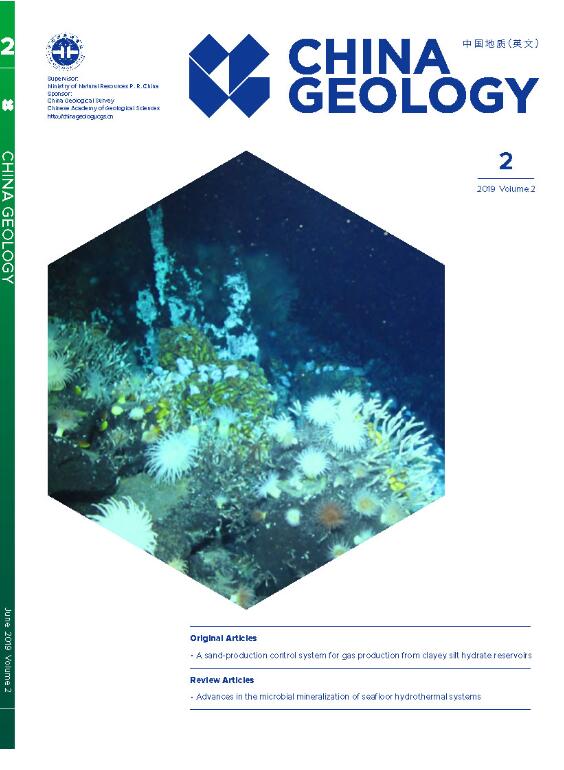

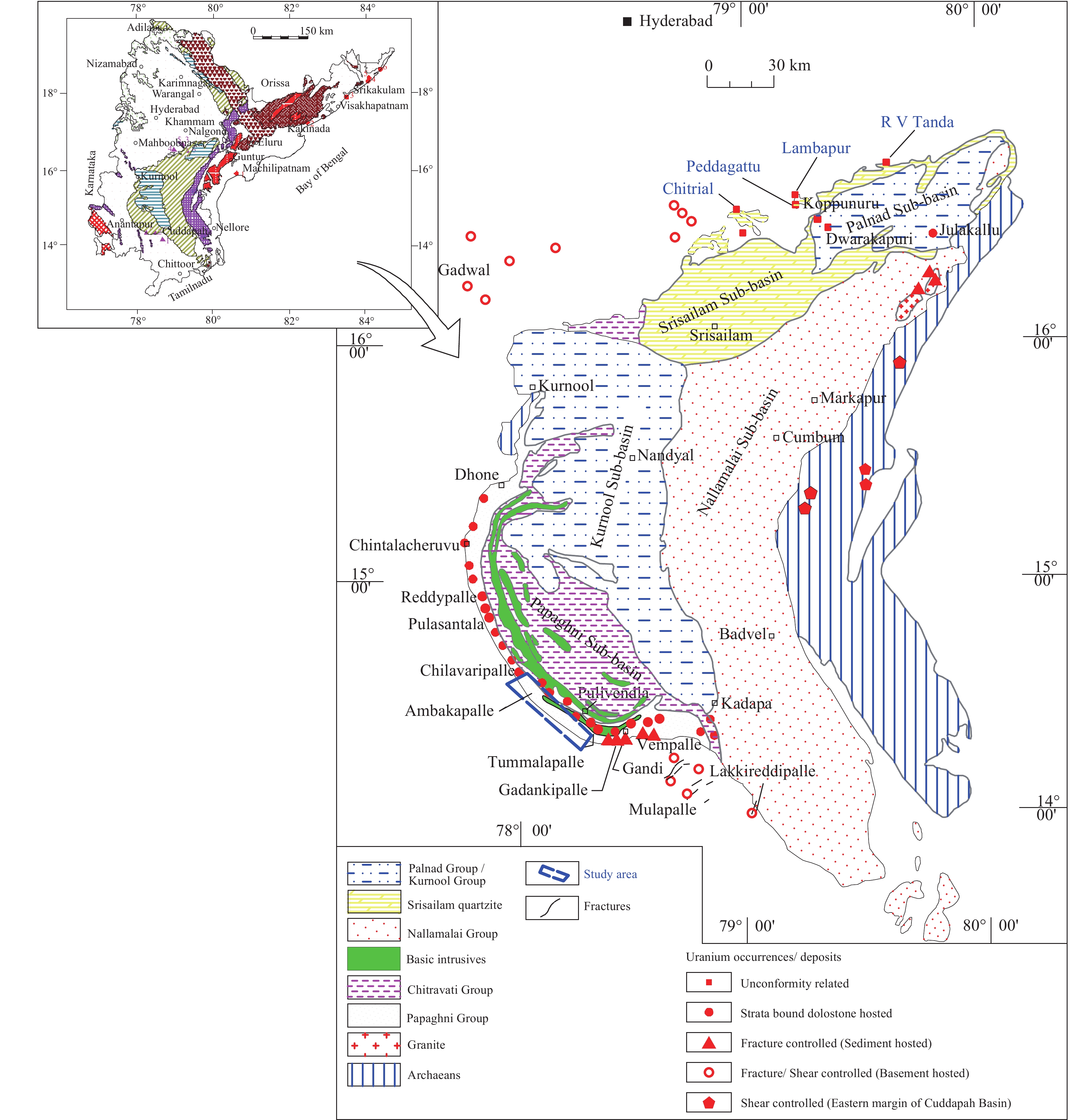

 DownLoad:
DownLoad:
